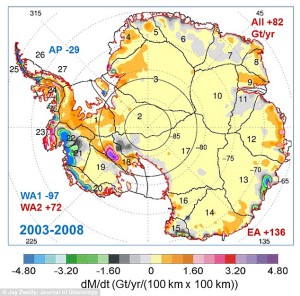 A new study conducted by NASA has revealed that Antarctica has actually seen more cumulative ice gains than it has seen losses.
A new study conducted by NASA has revealed that Antarctica has actually seen more cumulative ice gains than it has seen losses.
The study, led by Glaciologist Jay Zwally, shows that while the Antarctic Peninsula and parts of the West Antarctic continue to lose ice, the eastern side of the continent and interior of West Antarctica have recorded significant ice gains.
Furthermore, it has been determined that the ice caps are not actually contributing to the rising sea levels as much as scientists have originally thought.
These groundbreaking conclusions are based on new measurement methods that examine the height of the region’s ice sheet view satellites.
“The good news is that Antarctica is not currently contributing to sea level rise, but is taking 0.23 millimeters per year away,” Zwally stated. “But this is also bad news. If the 0.27 millimeters per year of sea level rise attributed to Antarctica in the IPCC report is not really coming from Antarctic, there must be some other contribution to sea level rise that is not accounted for.”

Until these discoveries were reported by NASA, it was believed that ice loss in Antarctica was the reason for the rise in global sea levels. Scientists believed that Antarctica was adding around 8% to global sea rise. The rising sea levels is a concern for many coastal cities around the world, such as Miami, where recent high tides have caused flooding.
If Jay Zwally’s study proves to be correct, it would mean that Antarctica is not contributing nearly as much to the increasing sea levels as originally thought.
Scientists may very well be underestimating the impact of other possible sources of rising sea levels, including melting from Greenland or the heating of the oceans.
If you would like to learn more about this discovery, please check out this article.